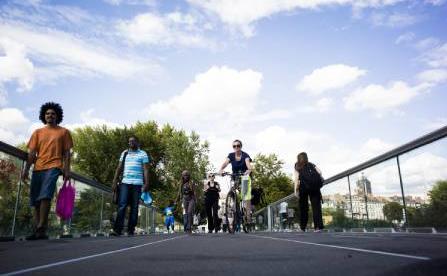Temperatures are soaring, waters are rising and becoming more acidic, the climate is going haywire.. The main culprit: carbon dioxide. We produce this greenhouse gas (GHG) on a massive scale, mainly by using fossil fuels (oil, gas, coal). The result? An increase in its concentration in the atmosphere, exacerbating global warming. The good news? We can all take action - consumers, manufacturers and businesses - to 'cool' the earth and work together for a more sustainable and desirable future.
Decarbonisation refers to all actions aimed at reducing or eliminating carbon dioxide emissions at the level of a country, an economy, a company or even an individual. Although the greenhouse gases contained in the atmosphere play a decisive role in regulating the climate by preventing some of the sun's energy from being reflected back from the earth into space - this is the greenhouse effect (without its action, the earth's temperature would be -18°C!) - their excessive concentration poses a problem. Human activity and the use of fossil fuels are to blame.
These emit excessive quantities of greenhouse gases (mainly carbon dioxide) into the atmosphere. By trapping the sun's heat, these gases cause global warming and climatic disturbances such as rising temperatures, melting glaciers, rising sea levels, extreme weather events and imbalances in ecosystems. The main challenge of decarbonisation is therefore to combat global warming and climate change.
Decarbonisation : what can be done?
To combat the increase in greenhouse gas emissions and thus limit global warming, there is only one watchword: decarbonisation. There are many things we can do to reverse the trend, in all sectors and at all levels of the population. In terms of transport, taking the bike or the train instead of the car, carpooling, avoiding the plane for short distances that can be covered with more gentle forms of mobility are all solutions that avoid and limit greenhouse gas emissions. In short, it's a question of opting for greater sobriety and efficiency in order to consume less and better. With one major objective: to reduce the use of fossil fuels and favour local, sustainable and low-carbon renewable energies.

Decarbonisation : Veolia commits to carbon neutrality
Aware of the vast challenges we collectively face, Veolia has committed to making all its water and waste services energy self-sufficient in France by 2027. These include the widespread production of biogas through the methanisation of organic waste and sewage sludge, the increased production of electricity from non-recyclable waste such as biomass or solid recovered fuel (SRF), the waste heat recovery, the installation of photovoltaic panels on closed landfill sites, and an increase in the use of renewable energy.
The Group is working alongside its customers to reduce their CO2 emissions. How can we do this? Veolia has developed four main levers to support its customers in this transition over the long term. The idea? To build a more desirable and sustainable future by pooling our efforts through the application of concrete Veolia solutions:
Improving energy management, through the Hubgrade by Veolia offer, and in particular setting up heating and cooling networks using low-carbon strategies to give priority to renewable energies.
Making the most of low-carbon energies in microgrids, through the development of "microgrids" that integrate green, local and low-carbon energies.
Pooling energy infrastructures, by helping industrial parks to pool their infrastructures, to ensure better overall management of their resources, energy expenditure and CO2 emissions.
Measuring and certifying CO2 emissions, by measuring our customers' environmental footprint and putting in place roadmaps tailored to each customer's objectives.

Through its GreenPath Zero Carbon offer, Veolia is supporting its customers on their zero-carbon path. On the programme: no fewer than 100 solutions to reduce the impact of their activities on the climate. How does it work? Through a tailor-made decarbonisation roadmap, the actions to be taken - to preserve and restore resources, optimise energy efficiency, create green energy loops or optimise materials recycling - are deployed.
Examples of decarbonisation solutions :
- Replacing Solvay's coal-fired boilers with a cogeneration plant fuelled by solid recovered fuels. The result? The production of clean, competitive energy and a reduction in CO2 emissions of 240,000 tonnes per year, or 50%.
- Also worth noting is the example of the European Metropolis of Lille, which is putting an end to its dependence on coal by recovering and converting into energy the steam produced by the incineration of its waste, 350,000 tonnes/year, to heat more than 35,000 homes and supply 20,000 with electricity, with a reduction in CO2 emissions of more than 50,000 tonnes each year.
- In Pécs, Hungary, 400,000 tonnes of CO2 per year have been avoided thanks to the installation of a cogeneration plant using 180,000 tonnes of biomass fuel to produce heat and electricity, heating more than 31,000 homes and 450 public buildings. It is the largest biomass-fuelled heating network in Europe.
Our energy solutions:
Veolia's role is to encourage the use of local, renewable and decarbonising energy resources to help local authorities, industrial companies and businesses improve their environmental footprint. For example, the Group is contributing fully to the decarbonisation and regeneration of resources to enable the city of Hong Kong in China to achieve the ambitious goal of carbon neutrality by 2050.
In addition to a giant sewage sludge treatment plant that is entirely self-sufficient in water and electricity, and the construction of a storage site for non-recyclable waste to optimise methane capture and avoid the emission of 10 million tonnes of CO2 over 20 years, the Group is creating local energy loops through cooling and heating networks. The new Kai Tak district benefits from the very first public district cooling system. With a cooling capacity of 284 MW, the facility uses chilled water as the cooling medium for the air-conditioning system, replacing traditional air-based methods, which are much more energy-intensive and emit GHGs.
Against a backdrop of dwindling energy resources and the need to reduce carbon emissions into the atmosphere, all the Veolia solutions deployed throughout the world demonstrate that it is possible to effectively decarbonise the energy sector.


